Ban Fracking Now!
• Albany Action Says Ban Fracking in New York and Everywhere
•
Stop Fracked Gas Exports at Cove Point, Maryland • We Cannot Let Maryland Become a Greenhouse Gas Hot Spot • A Dirty Energy Emancipation Proclamation: In Utah?
Albany Action Says
Ban Fracking in New York and Everywhere

![]()

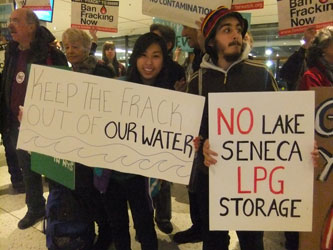
![]()
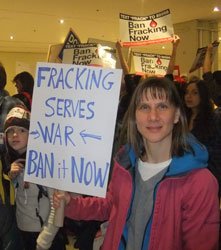

![]()
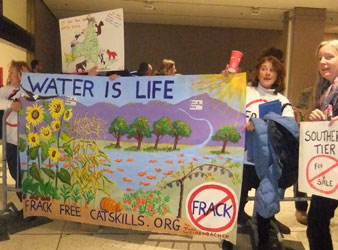
[TOP]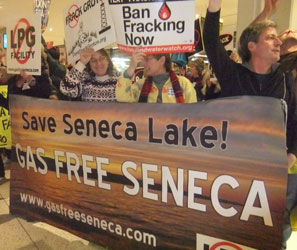
![]()
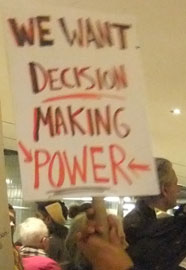
Stop Fracked Gas Exports at Cove Point, Maryland
 The natural gas industry is proposing a dangerous and costly detour from our region’s clean energy future: They want to build a web of new pipelines and processing plants across Maryland and Virginia in order to export natural gas to overseas markets.
The natural gas industry is proposing a dangerous and costly detour from our region’s clean energy future: They want to build a web of new pipelines and processing plants across Maryland and Virginia in order to export natural gas to overseas markets.
The development of Cove Point, a liquefied natural gas (LNG) export facility located right on the Chesapeake Bay in Southern Maryland, is the linchpin in this plan. Dominion’s Cove Point facility is the first LNG export terminal slated for the East Coast. It would drive demand for a surge of new hydraulic fracturing, or “fracking,” for gas in our region and require an expanding network of new fossil fuel infrastructure. While the gas industry would profit, we would pay the price of scarred landscapes, polluted air and waterways, livelihoods at risk, and worsened climate change.
Sign up to join us on February 20 in Baltimore for a rally outside the Public Service Commission. They will be reviewing Cove Point permitting inside, and we will rally and march outside to show that people across our region want clean energy and safe communities, not a mega-export facility for dirty fracked gas!
Exporting Fracked Gas to the World through Maryland
Dominion Energy wants Cove Point, originally built during the 1970s to import gas, to become the first liquefied natural gas export facility approved on the East Coast. The project would cost upwards of $3.8 billion dollars, require the construction of an energy-intensive plant on-site to liquefy and cool the gas, draw a surge of tanker traffic into the Bay — and enable the export of over one billion cubic feet of carbon-emitting fracked natural gas per day.
The rapid expansion of dangerous fracking has led to a glut of gas in the U.S. Exporting LNG is the industry’s opportunity to drive up gas prices at home and drive up its own profits — at our communities’ expense.
Fact: The new liquefaction facility that Dominion would have to build on-site to process gas for export would emit more heat-trapping carbon dioxide than all but three of the state’s existing coal plants.
In all, given the energy-intensive process of extracting, transporting and processing gas for export, Cove Point would trigger more greenhouse gas emissions than any other single source of climate pollution in Maryland.
The Consequences for our Communities
LNG exports will increase pollution and health risks from gas drilling, processing and transport at home, turning our communities into industrial sacrifice zones for energy being shipped elsewhere.
If the Cove Point export facility is approved, it will provide a strong economic incentive for companies to expand fracking across our region, including in Maryland, where no drilling yet occurs. In other states, the expansion of fracking has caused drinking water contamination, air pollution, illnesses and even earthquakes.
Risking the Chesapeake Bay Economy and Ecology
The Chesapeake Bay supports more than a trillion dollars in economic activity through seafood and tourism. Exporting gas from Cove Point would increase traffic of massive, 1,000-foot long tankers carrying volatile, potentially explosive liquid fuel. Harmful emissions from those tankers would worsen local air quality. They would also dump billions of gallons of dirty ballast wastewater into the Bay each year. Construction of the gas liquefaction facility would require the clearing of forests and barging in of heavy construction materials along the Patuxent River, further threatening the network of rivers, wetlands and forests that attract tourists and support rare species of plants, animals and migratory birds.
A Web of Destructive Fossil Fuel Infrastructure
 To support the export of LNG on the East Coast, new pipelines will be needed throughout the Marcellus shale states to get gas from new drilling wells to the export terminal. Pipelines, which inevitably leak and rupture causing dangerous explosions and fires, would snake through our waterways, backyards and farms. Noisy, polluting compressor stations could be required from Fairfax, Virginia to Frederick, Maryland and everywhere in between to keep gas moving through pipelines. Residents of the small, rural town of Myersville, Maryland are already fighting a 16,000-horsepower compressor station that Dominion wants to construct, which would be located just a mile from their elementary school.
To support the export of LNG on the East Coast, new pipelines will be needed throughout the Marcellus shale states to get gas from new drilling wells to the export terminal. Pipelines, which inevitably leak and rupture causing dangerous explosions and fires, would snake through our waterways, backyards and farms. Noisy, polluting compressor stations could be required from Fairfax, Virginia to Frederick, Maryland and everywhere in between to keep gas moving through pipelines. Residents of the small, rural town of Myersville, Maryland are already fighting a 16,000-horsepower compressor station that Dominion wants to construct, which would be located just a mile from their elementary school.
Making Natural Gas More Expensive at Home
If all the proposed LNG export projects in the U.S. are approved, the result would be the export of more than 40 percent of our current production of natural gas. This means more competition at home, and thus, higher prices for domestic consumers and industries.
According to the NERA Economic Consulting Analysis commissioned by the U.S. Department of Energy, exporting natural gas harms every major sector of the U.S. economy, except the gas industry.
The Consequences for Our Climate
Cove Point is our region’s line in the sand on climate change. Looking at the big picture impacts of fracking, the International Energy Agency concludes that a worldwide reliance on fracked gas would lead to six degrees Fahrenheit of atmospheric warming, in other words, cooking the planet.
LNG exports are even more energy intensive than gas drilled and burned at home. After the gas is transported, liquefied for export and then re-gasified to burn, the lifecycle emissions of exported LNG are 15 percent higher than gas consumed domestically. To power liquefying and cooling operations, Cove Point would require construction of a new gas plant on-site that would be Maryland’s fourth-largest climate polluter. From start to finish of the LNG export process, Cove Point would trigger more planet-heating pollution than Maryland’s entire fleet of seven coal-fired power plants combined.
If we are going to preserve a safe climate, we can not open the floodgates to fracked gas exports on the East Coast — just like we cannot build the Keystone XL tar sands oil pipeline to the Gulf Coast or new coal export terminals on the West Coast. We can and must invest instead in clean energy, making our region a leader in offshore wind power, new solar installations and energy efficiency, technologies that will create jobs and grow our economy permanently and safely.
Fact: If Dominion redirected the money it is investing in Cove Point toward wind power, it could increase the East Coast’s installed wind capacity by 50 percent and create more than 7,500 jobs.
[TOP]
We Cannot Let Maryland Become
a Greenhouse Gas Hot Spot
 The comparison to a Road Runner cartoon would be comical if it were not so apt. Wile E. Coyote paints an elaborate faux exit ramp off a main road, with arrows and lighted signs saying, “Go this way!” It heads, of course, to a sheer cliff.
The comparison to a Road Runner cartoon would be comical if it were not so apt. Wile E. Coyote paints an elaborate faux exit ramp off a main road, with arrows and lighted signs saying, “Go this way!” It heads, of course, to a sheer cliff.
Virginia-based Dominion Resources is asking Maryland to do just that: run off a cliff. In rural Calvert County, along the placid Chesapeake Bay, the company is proposing a $3.8 billion facility to liquefy more than 750 million cubic feet of natural gas per day and ship it to India and Japan. That gas would come from controversial “fracking” wells drilled across several states, potentially including Maryland.
A careful review of Dominion’s application to the Maryland Public Service Commission (PSC) shows how this one facility would turn Maryland — a state with relatively progressive global-warming policies — into a regional dumping ground for carbon pollution.
The permitting process for the plant is complex and involves state and federal regulators. But the numbers are staggering, and they serve as a caution to the rest of the nation, where 25 facilities to export liquefied natural gas (LNG) have been proposed. According to Dominion’s numbers, its Cove Point LNG facility would emit more global-warming pollution annually — 3.3 million tons of carbon dioxide — than do most of the state’s dirtiest coal-burning power plants. Why? Because chilling natural gas to 270 degrees below zero — the temperature at which it becomes liquid and can be pumped onto tankers — is a process that requires a lot of energy.
Dominion wants to build a utility-scale power plant on site — 130 megawatts — just to power part of the liquefaction process. The company would also burn gas to run various pumps, chillers and compressor equipment. None of this, mind you, would add a single kilowatt-hour of electricity to the Maryland grid. We would get no new power whatsoever.
What we do get is a new pulse of greenhouse gas pollution so large it would take more than 2.5 million acres of new forest land to offset it. And, oh yeah, according to the Energy Department, upward pressure will be applied to domestic energy prices. Such increases hit low-income consumers hardest.
But that is just the start. In its PSC application, Dominion does not include the full pollution consequences of exporting this fuel from fracking wells. Those wells are spreading across much of Appalachia — though not yet in Maryland — thanks to new drilling techniques that employ pumped water, toxic chemicals and underground explosives. Exporting that gas will not only raise its price, it will also stimulate the drilling of still more wells. As part of the extraction process, each of these wells will inevitably emit some of the powerful heat-trapping gas methane (whose greenhouse effect is 25 times larger than carbon dioxide’s). Then the gas has to be piped all the way to Calvert County (with more inevitable methane pollution along the way). Then liquefied (the CO2 pollution). And then put on tankers (more CO2).
All this, remember, before the gas is ever burned to make power overseas, which, as with any fossil fuel, results in large CO2 emissions. Hence the cliff.
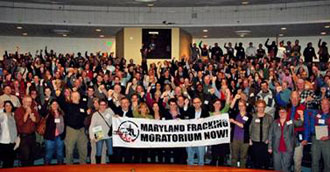 But Dominion insists there is no pollution ledge here. No economic ledge, either. It paints an elaborate detour sign with signs saying: “New Jobs This Way!” And “Tax Revenue for Politicians Here!” And “Trust us: Gas is the Good Fossil Fuel.” These could be strong lures for federal and state policymakers, tempting them to steer the state off its present course of reducing carbon emissions 25 percent statewide by 2020. So let us take a look.
But Dominion insists there is no pollution ledge here. No economic ledge, either. It paints an elaborate detour sign with signs saying: “New Jobs This Way!” And “Tax Revenue for Politicians Here!” And “Trust us: Gas is the Good Fossil Fuel.” These could be strong lures for federal and state policymakers, tempting them to steer the state off its present course of reducing carbon emissions 25 percent statewide by 2020. So let us take a look.
Jobs? Dominion says the Cove Point facility would create a paltry 130 permanent jobs. And many of those could be highly specialized workers from overseas. Taxes? True, Calvert County and the state would get a few million dollars annually in new revenue. But is this worth turning the state into a regional emissions sewer? And good fossil fuel? As illustrated above, this is the biggest myth of all. Pollution from drilling, leakage from piping, emissions from massive export tankers: By any reasonable analysis — conducted using publicly available data from the Environmental Protection Agency, the International Energy Agency and others — it is clear that the life-cycle greenhouse gas emissions of fracked and exported natural gas are nearly as bad as — and potentially worse than — the life-cycle emissions of coal.
Tragically, if state and federal officials approve the Cove Point project, all of these negative impacts would occur. Accounting for all impacts, this one facility would become the biggest cause of global-warming pollution in Maryland. Or, as one Cornell University scientist has said, fracked gas is not a “bridge fuel” to a cleaner future. It is “a gangplank” to a climate calamity.
If, on the other hand, the facility is not constructed, then much of this gas may very well stay in the ground and the emissions avoided. Non-polluting energy like wind and solar would then gain better footing. We stay on course. No detour.
Dominion could simply propose another export facility in another coastal state, of course. But that state’s residents might object to becoming an international sacrifice zone, too. And so might others, battling other export terminals nationwide, be emboldened and inspired by Maryland’s stance.
And then, suddenly, we all avoid the cliff.
[TOP]
A Dirty Energy Emancipation Proclamation:
In Utah?
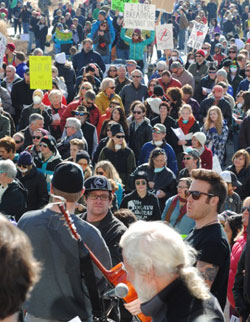 On January 25, away from the spotlight of Washington, DC, The New York Times and even MSNBC, one of the largest, and most significant environmental protests in years took place in the most unlikely of places — Salt Lake City, Utah. […]
On January 25, away from the spotlight of Washington, DC, The New York Times and even MSNBC, one of the largest, and most significant environmental protests in years took place in the most unlikely of places — Salt Lake City, Utah. […]
People from all of Utah’s main cities decided they were, “sick - literally - and tired” of Utah’s dirty air. They were also sick and tired of lip service by legislators and the governor. And on Saturday, January 25, that frustration reached critical mass. Almost 5,000 people poured onto the state Capitol grounds spurred by the theme, “Clean Air, No Excuses.”
They came armed with a petition that demanded reforms in transportation, real mass transit, and a moratorium on freeways. It demanded that one of the last standing medical waste incinerators, Stericycle, in the heart of the suburbs, be shut down, and that open burning of any type, by businesses, agriculture or individuals be prohibited. For our largest industrial polluters, the Rio Tinto/Kennecott copper mine and five oil refineries, it demanded maximum pollution controls and no more expansions, and air quality standards stricter than the EPA’s. Perhaps most significantly, it demanded an end to the state government’s push to make Utah the dirty energy capitol of the West, and no permitting of oil shale drilling and tar sands. It was a “dirty energy emancipation proclamation.”
Some Background
Utah is home to unique, spectacular natural beauty — from snowcapped peaks to awe-inspiring national parks with majestic red-rock monoliths and Colorado Plateau canyons. […] For years, Utah’s legislature, governor, and Congressional delegation have been staunchly pro-business, chest thumping in their antipathy toward federal regulation of any kind, reliable cheerleaders for the fossil fuel industry, and predictably annoyed by, if not mocking of, anyone suggesting the environment needs protection.
In the winter, Utah’s darker personality comes out of the closet. The heavily urbanized areas of the state perennially rank in the top ten worst cities in the country for acute spikes in air pollution. Typical winters are spent with much of the time under “inversion” circumstances, where cold air gets trapped near the floor of our high mountain valleys (where most of our population lives), and warm air above acts like an atmospheric lid, preventing the dispersion of pollution. […]When inversions set up, children are kept indoors during recess, elderly are advised not to venture outdoors, hospital beds fill up, emergency rooms become crowded and mortality rates rise.
Beyond the meteorologic trigger of our inversions, many of the usual cast of characters play a role in our pollution — sprawl instead of real urban planning, insufficient mass transit, auto exhaust, heavy industry like oil refineries and mining […]
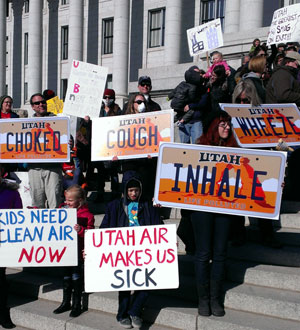 Virtually unrecognized by the media, and unacknowledged by state government, has been the role of the explosion of oil and gas drilling, using hydrofracking, in the Uinta Basin about 180 miles east of Salt Lake City. Fugitive emissions inherent in oil and gas drilling have created a severe air pollution problem in Vernal, the main Utah town in the Uinta Basin. In the winter, Vernal has particulate pollution as high as Salt Lake City but can also have ozone higher even than Los Angeles — a double whammy unique to Vernal. And now our “dirty energy” governor is heavily promoting extreme fossil fuels in Utah — which has the lower 48 states’ primary deposits of oil shale and tar sands. I suppose those glamorous photos of the Alberta Tar Sands eco-nightmare are just too alluring for our governor to pass up. Tar sands and oil shale would seal a fate for Salt Lake City of perpetual, doomsday air pollution.
Virtually unrecognized by the media, and unacknowledged by state government, has been the role of the explosion of oil and gas drilling, using hydrofracking, in the Uinta Basin about 180 miles east of Salt Lake City. Fugitive emissions inherent in oil and gas drilling have created a severe air pollution problem in Vernal, the main Utah town in the Uinta Basin. In the winter, Vernal has particulate pollution as high as Salt Lake City but can also have ozone higher even than Los Angeles — a double whammy unique to Vernal. And now our “dirty energy” governor is heavily promoting extreme fossil fuels in Utah — which has the lower 48 states’ primary deposits of oil shale and tar sands. I suppose those glamorous photos of the Alberta Tar Sands eco-nightmare are just too alluring for our governor to pass up. Tar sands and oil shale would seal a fate for Salt Lake City of perpetual, doomsday air pollution.
Public Demands Protection for Environment
For those of us who organized the January rally and worried about whether it would indeed become the blockbuster event we had hoped, we were literally overcome looking out from the Capitol steps to see thousands of Utah parents, grandparents, patients, doctors, athletes, children and students coming on trains, buses, in car pools, on bicycles and on foot, all marching up the hill to the Capitol building. It was an unforgettable moment of inspiration to see so many diverse groups join together in wanting to make our community a better place to live. Several hundred signs showed the work of creative geniuses: they ranged from “Utah’s Air: 50 shades of gray.” to “Smog Lake City.” About 1,000 people wore masks, some for the symbolism, and some out of desperation to do anything to protect themselves and their children.
For most of them, like our Master of Ceremonies Dick Nourse, a beloved retired local TV news anchor, this was their first experience formally “protesting” anything. Their protest represented a new degree of courage and determination to make their government function and also an abiding hope, as difficult and intractable as it may seem, that this problem can indeed be solved.
Emotions ran high, with widespread frustration, disappointment, and sadness for our beloved community, which should be a source of pride in so many other ways, but has become so visibly degraded and spoiled. Thousands were angry for being denied their most fundamental right — the right to breathe clean air — and angry at many of Utah’s leaders for failing in their most important obligation. They said they are tired of a state government detached, paralyzed, or immune to the issue, unable or unwilling to offer anything but token gestures. They demanded not just clean air, but clean energy and a clean future. […]
[TOP]
